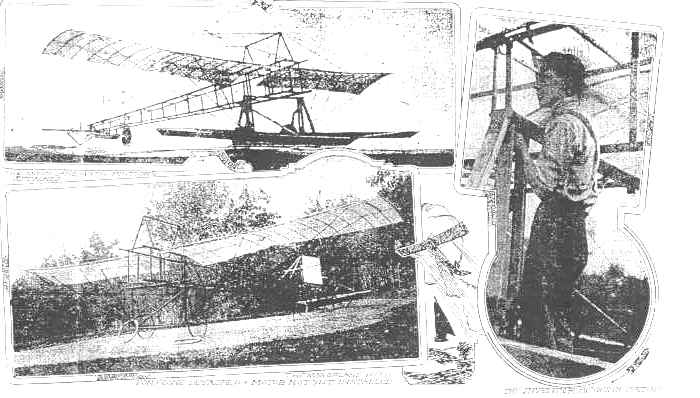
 |
 |
|
That another bird man is about to bow to the public can plainly be seen by any one who happens to be favored with a glimpse of the
workshop of Reyburn Watres at Pen-y-bryn The young inventor is the son of Col. O.A. Watres, and his home and workshop is in the Watres mansion on the mountain. He is a quiet, unassuming young man, and it was only after repeated requests that he decided to bring out his "hobby bird.." The aeroplane is of the monoplane type and measures thirty-five feet from tip to tip of wings. It resembles the tiny Demoiselle machine in general appearance but is nearly twice the size, the Demoiselle, measuring only eighteen feet from tip to |
tip. The construction shows the results of much study and
experimenting. It may not be generally known that the different woods and metals possess different qualities when it comes to a
question of tension, some being adapted to lateral and some to longtitudinal tension. To properly use each wood and metal requires
a great deal of study and experimenting. The steering gear is operated part by hand and part by foot. The hands operate levers to control the rudders at the tail, which cause the machine to rise and fall or turn to right or left. The lever controlling the warping of the wings, which operation is used in circling is controlled by the feet. Another feature is the |
pontoon or hydroplane attachments. These are small boat like arrangements under each wing and near the tailpiece, which will enable
the machine to start from the water as well as from the land. So far this feat has been tried but once and then by Glenn Curtiss at Lake Keuka. Mr. Curtiss did not have much success with the water stunt and had been too busy since then with the different aviator meets to experiment further along that line. At the time the pictures were made it can be seen that the engine was not in place. Mr. Watres is also building his own engine and has several very good ideas heretofore untried. The engine is of the vertical type and consists of four clinders, |
water-cooled. The cooling device, instead of being constructed of a nest of pipes as in most radiators, consists of a line of piping running aroung the
entire body of the machine and give a much greater cooling surface than the old type of cooler. The water in the cooler is, of course,
operated by pumps. The engine is so built to give about fifty-horse power, but will undoubtedly develop at least
seventy-five. The machine is exceedingly light and with the power at command should prove a very speed craft. Mr. Watres expects to give it a thorough trial on the ice at Lake Scranton this winter, before making a more public demonstration next Spring. |
Collection of Louis Arthur Watres, 9-19-06 |
Application Filed Jan 1, 1910, Serial No. 539,265 Patent Name: INTERNAL COMBUSTION ENGINE Patent Inventors: Lewis S. Watres and Reyburn Watres, of Scranton, Pennsylvania "..invented a certain new and useful improvement in Internal-Combustion Engines.....the high pressure and low pressure cylinders and pistons are concentric..... The high pressure piston is in the center and is separated from the surrounding low pressure piston by an appropriate annular space occupied by the wall separating the high pressure cylinder from the low pressure cylinder..... The engine is of the two-cycle type. |
|
It is not known if the engine withing the patent was the engine for the Watres aeroplane. The plane flew in 1910. Reyburn Watres nicknamed his monoplane "The Grass Cutter." Reyburn flew his aircraft a number of time, primarily at his airfield in the Lake Wallenpaupack region. In time Reyburn determined that hte pontoons he used on his aircraft were designed inappropriately. They were of a straight-line fashion similar to that of a boat, where the pontoon design devised by Glenn Curtiss was with an inwardly curve to offer lift of the aircraft. Floyd Hawk, of Scranton, was the chauffer of Col. Louis A. Watres, and assisted Reyburn with his aeroplane. Mrs. _____ Rose, of Hawley, was a daughter of the Kellam family. Reyburn stayed with the Kellam family when he was in Pike County "tuning" and flying his aeroplane. It is no known where the remains of the Watres aircraft are today. Well below the surface of Lake Wallenpaupack. Reyburn was Editorial Writer of the Scranton Tribune, Republican until it was sold in 1934. The Watres family owned the paper. Facts that need clarifying: Sons of Col. Watres: ?? . Harold. . Eldest . Laurence H.. 2nd Son . Reyburn. . Youngest What was your grandfather's correct name? . Patent records show his name as Lewis S. Watres. Lewis S. Watres was a nephew. . Other documentation shows his name as Col. L. A. Watres. Col. Watres never filed a patent application. Rep. Laurence H. Watres of Penna, chief sponsor of the Watres Act. |
from Aviation Resource Center |


|